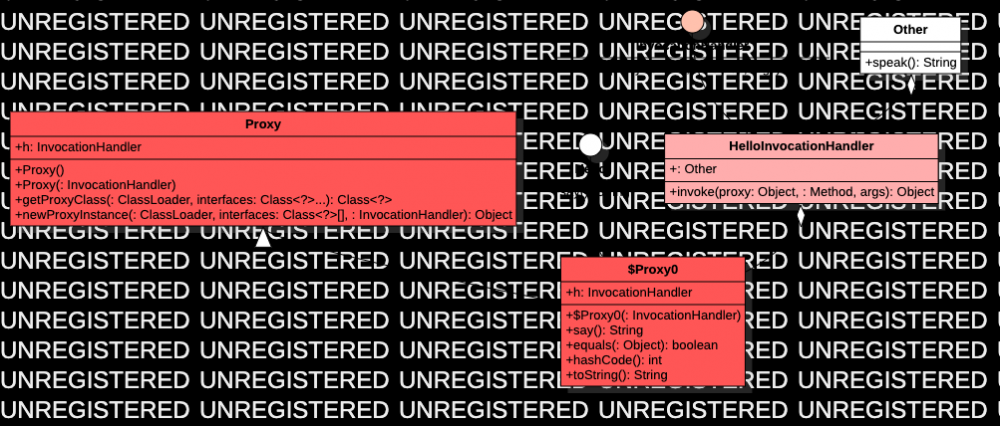Java动态代理
简介
主要来自极客时间 《RPC实战与核心原理》
从示例代码开始说起
给 Hello 接口生成一个动态代理类,并调用接口 say() 方法,但真实返回的值居然是来自 Other 里面的 speak() 方法返回值。
// 要代理的接口
public interface Hello {
String say();
}
// 真实调用对象
public class Other {
public String speak(){
return "i'm proxy";
}
}
// JDK代理类生成
public class HelloInvocationHandler implements InvocationHandler {
private Object target;
HelloInvocationHandler(Object target) {
this.target = target;
}
@Override
public Object invoke(Object proxy, Method method, Object[] paramValues) {
return ((Other)target).speak();
}
}
// 测试例子
public class TestProxy {
public static void main(String[] args){
// 构建代理器
HelloInvocationHandler proxy = new HelloInvocationHandler(new Other());
ClassLoader classLoader = ClassLoaderUtils.getCurrentClassLoader();
// 把生成的代理类保存到文件
System.setProperty("sun.misc.ProxyGenerator.saveGeneratedFiles","true");
// 生成代理类
Hello test = (Hello) Proxy.newProxyInstance(classLoader, new Class[]{Hello.class}, proxy);
// 方法调用
System.out.println(test.say());
}
}
-
Hello.say的执行会通过InvocationHandler.invoke被转到Other.speak。用AOP 里的术语 就是Other.speak是pointcut,InvocationHandler.invoke除Other.speak之外的其它部分是advise。 - 在一般的 动态代理 示例中,Other 会实现 Hello interface,
InvocationHandler.invoke最后会执行method.invoke(target,args)。但此处实例表明,InvocationHandler.invoke可以执行任意逻辑,可以自己实现所有逻辑,也可以是完全不相关的类的 不相关的方法 , invoke 方法参数 更多是提供被代理 方法的信息。
Proxy.newProxyInstance 里面究竟发生了什么?
public class Proxy implements java.io.Serializable {
private static final Class<?>[] constructorParams =
{ InvocationHandler.class };
public static Object newProxyInstance(ClassLoader loader,
Class<?>[] interfaces,
InvocationHandler h){
final Class<?>[] intfs = interfaces.clone();
final SecurityManager sm = System.getSecurityManager();
if (sm != null) {
checkProxyAccess(Reflection.getCallerClass(), loader, intfs);
}
// Look up or generate the designated proxy class.
Class<?> cl = getProxyClass0(loader, intfs);
// Invoke its constructor with the designated invocation handler.
if (sm != null) {
checkNewProxyPermission(Reflection.getCallerClass(), cl);
}
final Constructor<?> cons = cl.getConstructor(constructorParams);
final InvocationHandler ih = h;
if (!Modifier.isPublic(cl.getModifiers())) {
AccessController.doPrivileged(new PrivilegedAction<Void>() {
public Void run() {
cons.setAccessible(true);
return null;
}
});
}
return cons.newInstance(new Object[]{h});
}
private static Class<?> getProxyClass0(ClassLoader loader,
Class<?>... interfaces) {
if (interfaces.length > 65535) {
throw new IllegalArgumentException("interface limit exceeded");
}
// If the proxy class defined by the given loader implementing
// the given interfaces exists, this will simply return the cached copy;
// otherwise, it will create the proxy class via the ProxyClassFactory
return proxyClassCache.get(loader, interfaces);
}
}
Proxy 包括一个内部类 ProxyClassFactory
private static final class ProxyClassFactory
implements BiFunction<ClassLoader, Class<?>[], Class<?>>{
// prefix for all proxy class names
private static final String proxyClassNamePrefix = "$Proxy";
// next number to use for generation of unique proxy class names
private static final AtomicLong nextUniqueNumber = new AtomicLong();
@Override
public Class<?> apply(ClassLoader loader, Class<?>[] interfaces) {
Map<Class<?>, Boolean> interfaceSet = new IdentityHashMap<>(interfaces.length);
for (Class<?> intf : interfaces) {
Class<?> interfaceClass = null;
interfaceClass = Class.forName(intf.getName(), false, loader);
...
}
String proxyPkg = null; // package to define proxy class in
int accessFlags = Modifier.PUBLIC | Modifier.FINAL;
...
if (proxyPkg == null) {
// if no non-public proxy interfaces, use com.sun.proxy package
proxyPkg = ReflectUtil.PROXY_PACKAGE + ".";
}
// Choose a name for the proxy class to generate.
long num = nextUniqueNumber.getAndIncrement();
String proxyName = proxyPkg + proxyClassNamePrefix + num;
// Generate the specified proxy class.
byte[] proxyClassFile = ProxyGenerator.generateProxyClass(
proxyName, interfaces, accessFlags);
return defineClass0(loader, proxyName,
proxyClassFile, 0, proxyClassFile.length);
}
}
可以看到,ProxyClassFactory 显示生成了 Class文件 的byte[],然后通过defineClass0 加载到jvm 中。
sun.misc.ProxyGenerator.saveGeneratedFiles 控制是否把生成的字节码保存到本地磁盘。动态生成的类会保存在工程根目录下的 com/sun/proxy 目录里面,我们找到刚才生成的 $Proxy0.class,通过反编译工具打开 class 文件
package com.sun.proxy;
import com.proxy.Hello;
import java.lang.reflect.InvocationHandler;
import java.lang.reflect.Method;
import java.lang.reflect.Proxy;
import java.lang.reflect.UndeclaredThrowableException;
public final class $Proxy0 extends Proxy implements Hello {
private static Method m3;
private static Method m1;
private static Method m0;
private static Method m2;
public $Proxy0(InvocationHandler paramInvocationHandler) {
super(paramInvocationHandler);
}
public final String say() {
try {
return (String)this.h.invoke(this, m3, null);
} catch (Error|RuntimeException error) {
throw null;
} catch (Throwable throwable) {
throw new UndeclaredThrowableException(throwable);
}
}
public final boolean equals(Object paramObject) {
try {
return ((Boolean)this.h.invoke(this, m1, new Object[] { paramObject })).booleanValue();
} catch (Error|RuntimeException error) {
throw null;
} catch (Throwable throwable) {
throw new UndeclaredThrowableException(throwable);
}
}
public final int hashCode() {
try {
return ((Integer)this.h.invoke(this, m0, null)).intValue();
} catch (Error|RuntimeException error) {
throw null;
} catch (Throwable throwable) {
throw new UndeclaredThrowableException(throwable);
}
}
public final String toString() {
try {
return (String)this.h.invoke(this, m2, null);
} catch (Error|RuntimeException error) {
throw null;
} catch (Throwable throwable) {
throw new UndeclaredThrowableException(throwable);
}
}
static {
try {
m3 = Class.forName("com.proxy.Hello").getMethod("say", new Class[0]);
m1 = Class.forName("java.lang.Object").getMethod("equals", new Class[] { Class.forName("java.lang.Object") });
m0 = Class.forName("java.lang.Object").getMethod("hashCode", new Class[0]);
m2 = Class.forName("java.lang.Object").getMethod("toString", new Class[0]);
return;
} catch (NoSuchMethodException noSuchMethodException) {
throw new NoSuchMethodError(noSuchMethodException.getMessage());
} catch (ClassNotFoundException classNotFoundException) {
throw new NoClassDefFoundError(classNotFoundException.getMessage());
}
}
}
综上 可以得到一个类图

正文到此结束
- 本文标签: App ACE id 测试 IDE 参数 Property 目录 字节码 CTO http AOP 编译 类图 UI value Atom JVM https 时间 entity IO ssl zab map 实例 Security equals git 代码 src cache java Proxy cat HTML message HashMap struct GitHub final Action rmi newProxyInstance tar
- 版权声明: 本文为互联网转载文章,出处已在文章中说明(部分除外)。如果侵权,请联系本站长删除,谢谢。
- 本文海报: 生成海报一 生成海报二
热门推荐
相关文章
Loading...











![[HBLOG]公众号](https://www.liuhaihua.cn/img/qrcode_gzh.jpg)

